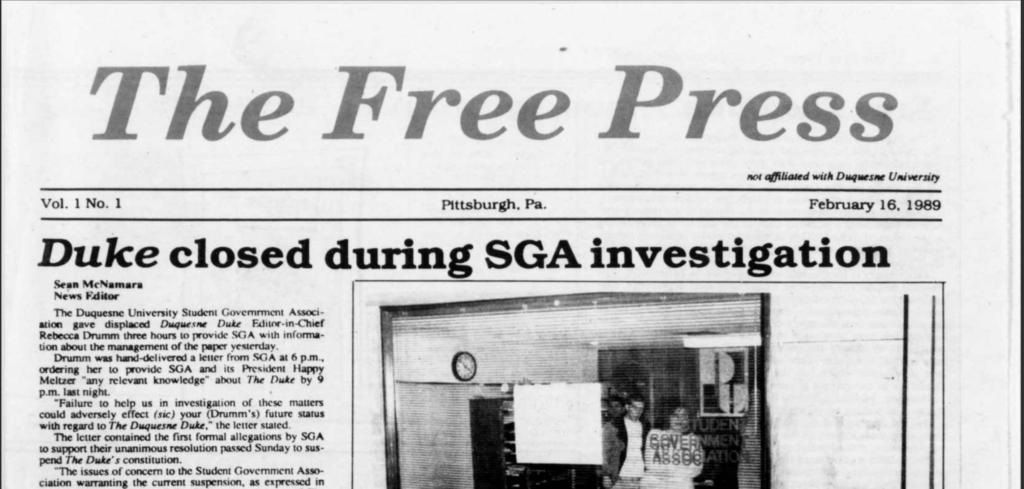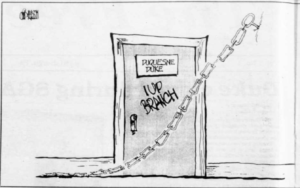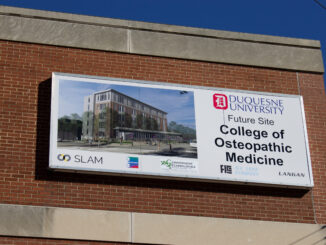
By Jamie Crow | Staff Writer
Since 1925, The Duquesne Duke has been serving the Duquesne community by reporting on the issues that matter. Thanks to the Gumberg Library Digital Collections, our 90-plus year history is always just a few clicks away. With that in mind, here is the fifth of many dips back into The Duke’s archives.
Censorship, a potential abuse of power and a lockout. This was the situation that The Duquesne Duke staff was facing in 1989. Early that February, The Duke was shut down because of a disagreement with the Student Government Association. The shutdown forced the paper to disaffiliate completely from Duquesne University and publish the Feb. 16, 1989 issue under its new name, The Free Press.
The Duke was shut down by the SGA following a disagreement when the paper published an advertisement for contraception counseling through the Family Health Council. The SGA said that the ad did not follow the mission statement of Duquesne University.
The SGA met with then Editor-in-Chief Rebecca Drumm to discuss their disapproval of the ad. The SGA told Drumm that if the ad ran again, the SGA would have to “take action” against the paper.

The ad ran again in the next issue of The Duke, accompanied by an editorial called “Censorship on the Bluff?” The editorial discussed the potential censorship that the SGA seemed to be threatening, along with a discussion of what freedom of the press really meant. After the ad ran again, the SGA sent Drumm a letter saying that the ad should not reappear, and if it did, the SGA would have to examine the operation of The Duke.
After receiving the letter, Drumm met with then Duquesne President John Murray, Jr., who suggested that if she chose to run the ad again it could be followed by a disclaimer that the ad did not necessarily reflect the views of Duquesne University.
The Duke published the ad again in the Feb. 2, 1989 issue with such a disclaimer. Four days later, on Feb. 6, the SGA unanimously decided to suspend publication of The Duke. The SGA then changed the locks to The Duke’s office, barring the staff from entry.
A letter from the SGA to Drumm followed on Feb. 7, stating that Drumm had three hours to prepare and present any information regarding management of the paper to the SGA.
As of the Feb. 16 issue, the dispute still had not been resolved. The displaced staff of The Duke kept with their publishing schedule, though, and through assistance from The Penn, Indiana University of Pennsylvania’s independent student newspaper, the first issue of The Free Press was able to publish according to the schedule.

The main story regarding the controversy occupies two of the paper’s four pages. The story was written by the news editor and his telling made an attempt to present The Duke’s side of the story without sounding biased.
Of course, it was clear what The Duke’s editorial board thought of the dispute. Their opinion was made even more clear through the other articles published in the issue. An article entitled “Free The Duke” called the SGA’s decision “tyranny” and an abuse of power. The article also takes a hit at the SGA, questioning the group’s ability to allocate funds to themselves.
Arguably the most opinionated and charged piece came from the displaced Editor-in-Chief, Rebecca Drumm. Her piece asked hard-hitting questions regarding censorship of a so-called free press. Drumm also placed at least part of the blame on Duquesne’s administration. Because Drumm herself was targeted, her article also focused on the allegations made against her and the legitimacy of her election to the position of editor-in-chief.
The controversy also spread off the Bluff to other campuses in the area. Carnegie Mellon University’s student senate unanimously passed a resolution that urged Duquesne’s SGA to reverse its suspension of The Duke’s publication. The Globe, the student newspaper of Point Park University, also spoke out against the actions of Duquesne’s SGA, with the editor of the paper saying that she was worried about similar instances of censorship happening on Point Park’s campus.
The situation between The Duke and the SGA took a month to resolve, with the next issue of The Duquesne Duke publishing on March 17 under its original name. There is still something to be taken away from the controversy even today. Our student publications as we know them were influenced by the dispute, and the situation gave way to the creation of the Duquesne University Student Publications Board which is made up of professors, students, faculty and one non-university affiliated media representative. The Student Publications Board works as a buffer between the administration, SGA and student publications.



